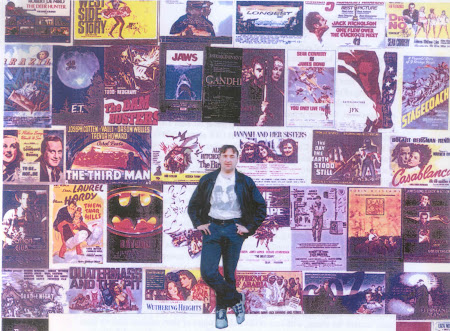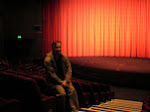The Millennium as an event seemed to come and go; much emphasis and fear was placed
 on the so-called "Millennium Bug" when 1999 ticked round to 2000, and in this country much scorn and finance was poured on the new Millennium Dome in North Greenwich - yet disappointingly little attention was paid to the history of the two thousand years of Christianity, in particular the 20th century. With the end of the 1990s rapidly approaching, I already had it in mind to compile some of my existing video footage into an end of the era celebration combined with key events and places of the 20th century. For this, I was also greatly assisted by my sister Catherine who provided an original score, the aim being to make (musically speaking) a modern perspective on events from the past as seen from the future, and vice versa - using Beethoven and others for the more universal themes of triumph and loss.
on the so-called "Millennium Bug" when 1999 ticked round to 2000, and in this country much scorn and finance was poured on the new Millennium Dome in North Greenwich - yet disappointingly little attention was paid to the history of the two thousand years of Christianity, in particular the 20th century. With the end of the 1990s rapidly approaching, I already had it in mind to compile some of my existing video footage into an end of the era celebration combined with key events and places of the 20th century. For this, I was also greatly assisted by my sister Catherine who provided an original score, the aim being to make (musically speaking) a modern perspective on events from the past as seen from the future, and vice versa - using Beethoven and others for the more universal themes of triumph and loss.A documentary can be one of the driest and dreariest forms of entertainment, dependent a great deal on the interest of its subject matter for most of its entertainment. To this end, I didn't want to make a film stuffed with facts and narration. I was captivated by the semi-poetic documentaries of Humphrey Jennings, as well as other visually dynamic films like Man with a Movie Camera and Berlin: Symphony of a Great City (which is homaged), to create not so much a documentary as a "visual symphony" of a film, incorporating not only the history of the times
 but also the three basic elements: earth, wind and fire - or to put it another way - the Rain, the Wind and the Sun.
but also the three basic elements: earth, wind and fire - or to put it another way - the Rain, the Wind and the Sun.Part I begins in early winter with the Rain (and snow) as a waking motif (just as the first sight of rain for Bambi was a defining moment), set to the beautiful "Aquarium" theme from Sain Saens' The Carnival of the Animals. Coastal tides are also a key visual metaphor - the tide of time, if you will.
Another influence was D.W. Griffith's Intolerance, from which instead of a rocking cradle I used the motif of a spinning bicycle wheel (its conclusion appropriately at the London Eye) - which moves the film on to the early part of the 20th century, and the continuing influence of technology which has fashioned the way we live now, beginning with factories and railways in the Industrial Age. This surge in machinery and ambition found its epitome in the RMS Titanic, for which, accompanied by a voiceover (by my father John) describing the tonnage of the ship when first launched and the fatal arrogance of its "unsinkability", the film
 poignantly visits some of the graves and memorials in Southampton to the Titanic disaster, including the actual spot where the ship first set sail on her maiden voyage.
poignantly visits some of the graves and memorials in Southampton to the Titanic disaster, including the actual spot where the ship first set sail on her maiden voyage.This was 1912, just two years before the start of the First World War, a suitable cue for the Wind to herald the first hurricane of armed conflict - a war that came to dominate most of the 20th century, with the wreckage of WWI spilling over into World War II in 1939.
In between comes the realm of the golden age of the cinema, when the silents became talkies, a particular pivotal moment when some of the greatest silent films were being made - in what would prove to be its last hu
 rrah - soon to be replaced by sound and an even greater, more far-reaching resurgence of spectacle with the musical, and the adventure epic (such as Captain Blood - right), and visiting the lovely Electric Palace in Harwich as a lasting monument to the era.
rrah - soon to be replaced by sound and an even greater, more far-reaching resurgence of spectacle with the musical, and the adventure epic (such as Captain Blood - right), and visiting the lovely Electric Palace in Harwich as a lasting monument to the era.After the jollity of going to the pictures, the mood shifts again to the more sinister parallel rise of fascism in the 1930's, and the country where it found its most pivotal advocate: Germany. Visiting one of the few remnants of the Nazi era still left in Berlin (the Olympic stadium designed by Albert Speer), and dwelling only fleetingly on the Nazi influence, the clearer perspective comes across the sea in England, where Winston Churchill makes his opening speech as Prime Minister, as the inevitable tide of World War II rushes in.
If ever there was an adaptation of William Shirer's The Rise and Fall of the Third Reich, in my mind's eye I imagined a bravura sequence where Hitler's speeches were intercut with the raging of tanks and planes through Europe, set to the music of Wagner's Ride of the Valkyries. The sequence culminates with the subsequent Japanese attack on Pearl Harbour, that proved to be the key moment in the Second World War: the enforced entry of America into the conflict. The rest, as they say, is violent history, and glossing over some of the further anguish and destruction of battle through the rest of the war, the film jumps forward to Churchill's announcement of the German surrender in 1945.
Such a conflict however could not go without mention of the Holocaust. Out of artistic principle I refused
 to show horrific images of bodies left for dead in the camps, as they are all too familiar and distressing nowadays, rather to show the horrified reactions of those who witnessed the atrocities at Buchenwald, set to the sorrowful music of Beeethoven's Miserere from Missa Solemnis. I visited Buchenwald in the autumn of 1999, on a breezy October morning, yet on the actual concentration camp site itself, there was an eerie stillness about it.
to show horrific images of bodies left for dead in the camps, as they are all too familiar and distressing nowadays, rather to show the horrified reactions of those who witnessed the atrocities at Buchenwald, set to the sorrowful music of Beeethoven's Miserere from Missa Solemnis. I visited Buchenwald in the autumn of 1999, on a breezy October morning, yet on the actual concentration camp site itself, there was an eerie stillness about it.Bringing some relief from all the warfare, I feature at this point some of the earliest family video footage of sentimental nostalgia value, before pushing on to the Sun (and Britain's would-be "solar eclipse" in 1999), and the fiery Atomic age, and with it the Cold War (so ironically named) at the turn of the 1960's. Going to Berlin o
 n the eve of the Millennium was a useful opportunity to see the Berlin wall (now a memorial art gallery) and the town hall in West Berlin where John F. Ke
n the eve of the Millennium was a useful opportunity to see the Berlin wall (now a memorial art gallery) and the town hall in West Berlin where John F. Ke nnedy made his famous "Ich bin ein Berliner" speech, speaking out from the free world to the Communist one. Kennedy's words still resonate 26 years later, when the Wall was finally broken and the East Germans were freely allowed to reunite with their loved ones in the West.
nnedy made his famous "Ich bin ein Berliner" speech, speaking out from the free world to the Communist one. Kennedy's words still resonate 26 years later, when the Wall was finally broken and the East Germans were freely allowed to reunite with their loved ones in the West.Cornucopia was finished editing and partial dubbing by April of 2002, at which point the Queen Mother died at the age of 101, and I'd already made the film to culminate with a photo montage of her through the years. It was a suitable
 tribute to someone whose life had literally spanned the century.
tribute to someone whose life had literally spanned the century.This film was a cathartic labour of love, from both a personal and a global perspective, about how time has fashioned the world around us, and one that I knew if it had to be done at all, it had to be done right. I claim no great filmmaking skills in depicting the drama, as the historical events were dramatic enough themselves. Intending originally for it to be made at the end of 1999, such a task was not possible, so I had to contend with finishing it at the beginning of the 21st century, which was perhaps appropriate as it acted as an ushering-in of the new millennium.
I also chose purposely to by-pass the most significant event of 2001 (the September 11th terrorist attacks), when that was really the first major moment of the 21st century. One can still reflect how that day was very much influenced by the lessons and experiences of the 20th century, and will for a long time to come.

